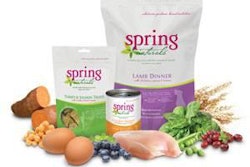A Q-and-A article in Natural Pet Product Merchandiser discussed with petfood industry professionals the role of functional foods in the retail sector, how to market the products and most effective ways to get customers to switch to these products.
Q-and-A panelists included two petfood manufacturers and two pet product retailers: Gary Bursell, CEO of Steve's Real Food; Jennifer Fadal, owner of Wag Natural Pet Boutique; Dale Greenbury, president of Full Petential; and Lisa Pearce, owner of Green Pawz Pet Supply.
Although functional foods were introduced in the 1980s, the concept has crossed over from human food into the petfood market, too, with petfood and treats claiming to have health-promoting or disease-preventing benefits. When asked about trends in functional foods at the ingredient level, Greenbury and Bursell both agreed that trends in petfood mimic those seen in human food.
"So you’re looking at things like probiotics, which are being heavily promoted on the pet side of the business right now, and natural antioxidants like superfoods, superfruits, noni, acai, blueberries," Greenbury said.
Bursell added: "Natural ingredients are a big item. Pesticide-free is important. You want to use meat that’s hormone-free, antibiotic-free. All the things that human beings are looking for in foods they’ve transferred to their animals."
At the retail level, Fadal said that coconut oil is becoming more mainstream in the pet market. Pearce said coconut chips are also popular at her store, and that "a lot of treats are trending toward the brain-nourishing sides with Gingko biloba and DHA." Other retail trends Fadal and Pearce noted are grain-free petfoods and treats, and lower calorie, simple treats.
Additionally, pet owners are becoming more concerned with pet allergies, Bursell said. Skin and coat health are also concerns of some pet owners, Fadal noted, as is gut health, Pearce said.
The manufacturers and retailers were also asked how they educate consumers about the benefits of functional foods. Bursell said his petfood company works to educate pet supply store owners, who then educate consumers. Store owners Fadal and Pearce said they work with veterinarians to educate themselves about the different petfoods they offer and attend training seminars to become more knowledgeable. Greenbury said that, as a manufacturer, he relies on the store owner for educating the consumer and store staff because "there’s only so much you can do in your packaging," while both Bursell and Greenbury said their companies rely on their websites as a primary means of consumer education.
According to Greenbury, a challenge facing petfood manufacturers in appealing to consumers is the labeling requirements mandated by the Food and Drug Administration.
"I’ll give you an example. We have a product that has DHA and omega-3 fatty acids. The proper term to use from AAFCO, the American Association of Feed Control Officials, is 'fat products.' Fat product is not the most appealing term to the consumer when you’re looking at a label. But, really, that product is 17 percent DHA, pure DHA," Greenbury said.
In the future, Greenbury said he would like to see something that would allow petfood companies to make statements about the actual functionality about the product. Both Fadal and Pearce agreed that education is also key, and that consumers need to be more educated about functional foods and their benefits to pets.
"My hope for the future would be that people become more aware of what they’re feeding and why they’re feeding it," said Pearce. "And not just, 'Oh, it’s in a green bag.' Everything that goes in that dog’s mouth counts. People need to be more aware of what they’re feeding and why they feed it."















